The Milam Apple: Legends and History
The Legends
Oliver Milam on his website concisely recounts the differing legends of the Milam Apple as told by Claude L. Yowell in his 1926 A History of Madison County Virginia [448] and by Judge W. E. Bohannon in his 1927 letter to H. M. Milam of Atlanta. Oliver also relates Aunt Polly's quote from The Adventures of Tom Sawyer (1876): "Here's a big Milum apple I've been saving for you, Tom, if you was ever found again -- now go 'long to school." [447 ] You may read them here (link) .
A History of the Milam Apple's Spread from Coast to Coast
The first description of the Milam apple appeared in the Magazine of Horticulture in 1846 under the heading, 'Notices of Several Varieties of Apples'.
"In our Volume 10 for 1844 we gave an account of a great variety of new apples, several of which were supposed to be native of the West {Ohio, Indiana, Illinois, etc.}. Since then other new varieties have been introduced to the notice of cultivators.....which we now present to our readers.....[449]
"Milan Probably a native of Virginia or Kentucky, where it is extensively cultivated and prized. Fruit: small, round, light red on a yellow ground; Fresh, white, tender, juicy, subacid, and fine flavored. It keeps till spring, and the tree is a great and constant bearer." [450]
 |
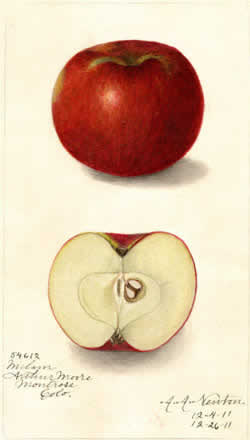 |
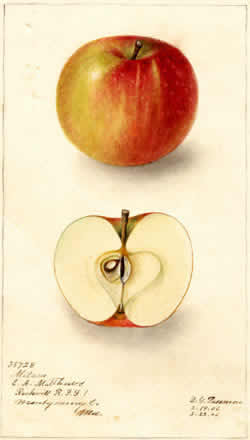 |
USDA National Watercolor Library, Pomological Watercolors
I have reviewed the esteemed reference books on fruit and fruit trees from the 19th century as well as the proceedings of state horticultural societies and dozens of tree nursery catalogs. The search for early horticultural history in Virginia is severely hampered by the devastation of the Civil War. The Virginia Horticultural Society was not founded until 1897. In 1901 the Virginia delegate to The 27th Session of the American Pomological Society reported that "the Horticultural Society was not very active....we have a local organization in Charlottesville and also one in Bedford County.” He added that orchardists were growing "the same old varieties" and that there was "very little spraying" to control pests. [451]
There was no mention of the Milam apple in Bernard M’Mahon’s 1806 list of "59 recommended apples" in the American Gardener’s Calendar [452]; nor in William Coxe’s 1817 list of "100 most estimable apples" in his A View of the Cultivation of Fruit Trees [453]; nor in William Kenrick's 1844 The New American Orchardist: An Account of the Most Valuable Varieties [454]; nor in A. J. Downing's first edition of The Fruit and Fruit Trees of America published in 1845. [455]
1854: F. R. Elliott in his Elliott’s Fruit Book described the Milam apple:
"CLASS III Unworthy of cultivation.
Milam. Harrigan. Winter Pearmain, of some.
American. Small to medium, roundish, greenish yellow, striped, dull red, flesh greenish, insipid; December, March." [456]
1859: Charles Downing in the 1859 edition of The Fruit and Fruit Trees of America now included the Milam apple:
"CLASS III. Contains those superseded by better sorts, yet many of them have qualities to recommend for certain localities and certain purposes. [457]
Milam. Harrigan, Winter Pearmain, of some.
Origin uncertain, much grown in some sections at the West {OH, IN, IL, KY, WI, etc.}, productive, keeps well. Fruit medium or below, roundish, greenish, shaded and striped with red. Flesh rather firm, pleasant, subacid, not rich. December, March." [458]
{By the way, in Downing's 1872 edition he adds the word "Good" to the description of the Milam apple and by 1881 he adds "very productive" - with greater experience the Milam apple became more highly regarded.}
Obviously beauty is in the eyes of the beholder. Elliott of Cleveland, Ohio, to some extent relied upon the opinions of fellow horticuturalists in ten states - but not Virginia. Charles Downing of Newburg, NY, thanked his consultants and colleagues in nine states - but also not from Virginia. To these experts, the Milam apple had one major flaw: its smaller than average size which was a problem for the large growers who desired to market apples to the cities.
Commercial orchardists had a choice of hundreds of apple varieties. Between them, Downing's 1845 and 1872 editions of The Fruit and Fruit Trees of America named 1,865 varieties of apples including 585 of foreign origin. [459] But if the Milam had a flaw, it also had major advantages for the many pioneers moving West - as we shall see.
1867: Dr. John A. Warder of Ohio traced the progress of fruit growing as it migrated west and southwest in his American Pomology and helps us understand one of the issues encountered by apple growers in the West {OH, IN, IL, KY, WI, MO}:
"To the South we of the West are looking with the greatest interest since we so often find that the northern fruits {NY, NJ} do not maintain their high characters in their southern and southwestern migrations; and all winter kinds are apt to become autumnal in their period of ripening which makes them less valuable; and because, among those of southern origin, we have discovered many of high merrit as to beauty, flavor and productiveness - and.....they prove to be long keepers, thus supplying a want which was not filled by fruit of Northern origin." [460]
Warder described the Milam Apple:
"Milam. Blair, rarely
This is another little Southern favorite to be found by almost every cabin in parts of the West. Whole orchards have been planted with sprouts of the mother trees, among the people to whom the art of grafting was an unheard of mystery. Now distributed by nurserymen all over the country. Tree moderately vigorous, twiggy, shoots reddish, foliage rather dark.....Flesh white, tender, crisp, juicy; Flavor mild subacid or sweet, agreeable and refreshing, but without any decided character; Quality good; Use, dessert; in cooking it lacks flavor; Season, December, January. [461]
1872: Finally, we learn details of Virginia pomology when James Fitz of Keswick, Virginia, authored The Southern Apple and Peach Culturist. The Milam apple is on no fewer than five different recommended lists in this book. He summarized the annual meeting of the American Pomological Society which was held in Richmond in 1871; its Committee of Revision developed the Southern and Western Apples Revised Catalogue which included the Milam apple among the 53 varieties. This catalog recommended it as "a Winter apple for Family and Market". [462] Fitz included the Milam on his List of Annual Bearing Trees. [463] The author also provided his recommendations for different geographic regions - based on the apple's actual performance in different climate and soil environments:
"LIST FOR THE MOUNTAINOUS SECTIONS OF THE SOUTH.
Including the Piedmont Region of Virginia and the Corresponding portion of Maryland.
Winter Apples:
Milam. Rather below medium size, smooth yellow, covered with marbled red, indistinct stripes; Flesh, white, tender, crispy, juicy; flavor subacid; Tree a regular annual bearer, very productive; November to February. Very popular in the Piedmont district where it succeeds admirably." [464]
"LIST FOR THE VALLEY OF VIRGINIA
Including West Virginia and Southwestern States (KY, TN, AR) and portions of the Western States (southern OH, IN, IL, WI, MO, KA).
Winter Apples:
Milam. (Already described.) This is a splendid apple in the Piedmont District of Virginia. Suitable for general cultivation." [465]
1883: In Barry’s Fruit Garden, P. Barry of Rochester, NY, main objective was "to bring to the notice of Cultivators the best Varieties, those which ample experience has shown to be really valuable.” His lists included 29 summer apple varieties, 32 fall, 102 winter and 21 crabapples. He provided an abridged description of each. The Milam apple was in the Winter List: [466]
Milam. – Origin doubtful. Medium or small, round; Greenish striped and shaded with red; flesh rather firm, pleasant subacid, not rich. – Late Winter. Tree hardy and productive. Valued at the West and Southwest.” [467]
1892: L. H. Bailey reported in the Annals of Horticulture of North America the results of his 1891 survey of the apple tree varieties sold by nurserymen in North America which was compiled from 95 fruit nursery catalogs. He found 878 varieties for sale that year. From the results he was able to estimate the geographic distribution of each apple variety. [468]
The Milam apple tree was for sale in 14 of the 95 catalogs: five catalogs in the Central Mississippi Valley (IL, MO, AR), three in the Southern Central States (WV, KY, TN), three in the Plains States (KS, NE), two in the Northern Central States (MI, OH, IN) and one in the Northwestern States (MN, WI, IA). You may view the chart for the Milam apple tree by clicking here (chart) .
Oddly he found none for sale in the catalogs from the Southern Atlantic States (MD, VA, NC, GA). Recently I surveyed dozens of fruit tree catalogs from the 2nd half of the 19th century and found the Milam apple tree for sale in five nurseries in Richmond, Virginia: Franklin Davis Nursery (1893), Hermitage Nursery (1869), Old Dominion Nursery (1897), Richmond Commercial Nurseries (1897) and Virginia Nurseries (1880). Not surprisingly, the Milam was also for sale in Falls Church (1900), Fredericksburg (1859) and Staunton (1858), Virginia, during this period.
Amazingly, I even found it for sale in the 1888 and 1893 catalogs of Rancho Chico Nursery in California, north of Sacramento. During the course of the nineteenth century, the Milam apple had literally spread from coast to coast.
 |
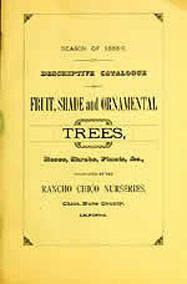 |
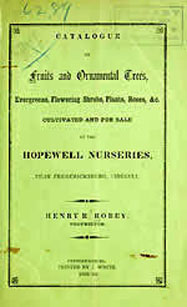 |
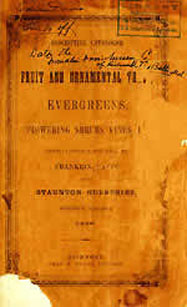 |
1903: Even though the Milam apple was "never grown much in New York state" and it was "practically unknown by New York fruit growers", S. A. Beach, the state horticulturist, was sufficiently impressed that he devoted a full page to it, providing a detailed description and citing 15 references in his report, The Apples of New York. Beach wrote in part:
"A medium sized dessert apple which has something of the appearance of a highly colored Rawls. In season November to March. The tree is thrifty and in favorable localities becomes productive when it is mature. Thousands of trees of this variety have been propagated from sprouts for it sprouts readily from its roots.....It formerly was quite popular in some portions of the Middle West where it is still propagated by nurserymen although it is not now planted as much as it was formerly." [469]
1908: USDA, Orchard Fruits in the Piedmont and Blue Ridge Regions of Virginia and the South Atlantic States
Milam. "Comparatively few growers have this variety in their orchards. Its small size restricts its usefulness to the home orchard, but its high dessert quality makes it of value in this connection. It may be used in the fall, yet under favorable conditions it can be kept until well into winter. Cecil sandy loam at 1000 feet altitude and Porter’s clay at 1500 feet appear to be favorable soil conditions for its growth in the Virginia portions of these regions. [470]
Milam Apple Vignettes From State Horticultural Societies
Since the Virginia Horticultural Society was not founded until 1897, we must search other societies to pursue the details of the popularity and spread of the Milam apple westward.
Ohio
Prior to 1796 there was very little fruit other than "the natural fruit of the soil" cultivated in Ohio. [471] Pioneers migrating west and southwest brought seeds from the best fruits in their region with them to plant. But most fruit trees grown from seeds {seedlings} were mediocre and most of their apples were only fit for making cider. Warder wrote: "...one in ten of our seedling orchard trees may be ranked as "good" but not one in a hundred could be styled as "best". [460] In 1817 Zebulon Gillett & Son began the second nursery in Ohio in Lawrence County - across the Ohio River from then Huntington, Virginia. The Milam variety as well as the Priestly, Roxbury Rosset, Blue Pearmain and Summer Harvey were propagated. [472].
Illinois
The first nursery in Illinois was planted by the enterprising Joseph Curtis in 1818 near the Wabash River on the border with Indiana. It is agreed that he was the inventor of "root grafting". According to his son, O. B. Curtis, reporting the history of Edgar County for the Illinois Horticultural Society, Joseph collected branches to graft from apple trees from Ohio, New Jersey and other states including these winter varieties: Milam, Jannette, Yellow Pippin, Smith Cider, Sweet Rhode Island Green, etc. They composed the first orchard of grafted fruits in Illinois. [473] Writing in 1869, O. B. Curtis elaborated:
"The Milam has been planted more extensively in the orchards of this county than any other... There are today more bearing trees of it than any six others....It is as popular here among apples as the Bartlett is among pears....Some of the learned nurserymen of the West have kindly suggested that the Milam was not a very good apple; but the farmers in old Edgar continue to grow and appreciate it as one of the indispensible varieties."
E. C. Hathaway recording the history of La Salle County for the same Society in 1870 wrote:
"The first orchards south of the Illinois River were set in 1833 or 1834....In 1837 Curtis and Sons, of Edgar County, came through here with a covered wagon loaded with trees, drawn by oxen. The wagon contained what are now the old orchards in the southern part of this county...The varieties were largely Milam and Rawles’ Janet, with several varieties not known to the farmers.... They have proved very productive and profitable." [474]
One of the "learned nurserymen" that O. B. Curtis was probably referring to above was Doctor J. A. Kennicott, a Chicago horticulturist, who is quoted by Elliott in 1865:
"Many of our varieties of the first trees transplanted in Western Illinois and southern Wisconsin were disseminated by tree pedlars from the region of the Wabash in Indiana and central-eastern Illinois....Among these pedlar’s trees the Red June is decidedly the most valuable, and the Milam the most abundant." [471]
H. J. Dunlap provided a history of Champaign County horticulture in 1870:
"...The first orchard planted was done about 1838 by William Sadoras....It was made of 50 Milam sprouts obtained near Terra Haute, Indiana, and afterwards extended by planting 150 more of the same. The trees commenced to bear in 1842...and continued to produce large annual crops until the deep freeze of 1855....Many other orchards were set out in this neighborhood from the sprouts produced by these Milams.
The only valuable apple planted seems to have been the Milam.....It is almost impossible to find a good eating apple in Champaign or Urbana during fall or early winter except the Milams...."[475]
O. B. Galusha gave a history of Grundy County in 1870:
“Plantings began in 1832 {and included the Milam}....The orchard which I planted on the prairie....in 1851 and 1852 consisted of sixty varieties of apples such as were then reputed to succeed well....in this part of the State.
For a list of the leading sorts which proved profitable, I refer the reader to my report....I will add to that list a few which succeeded well in my orchard and others where I have seen them in the county, viz. the Nonsuch, Henry Pippin, Golden Greening, May Hocking, Black Apple, Autumn Sweet, Milam – poor apple, but 'bears well, keeps well, and sells well'...." [476]
Summary
In 1905, the United States Department of Agriculture published a bulletin entitled Nomenclature of the Apple: A Catalog of the Known Varieties Referred to in American Publications from 1804 to 1904. It ran to almost 400 pages and listed 17,000 apples by name, including the Milam of course. In 2013 Tom Burford authored Apples of North America describing "192 exceptional varieties". The Milam apple is one of them. [477] Those statistics speak volumes about the place of the Milam Apple in pomological history.
We have learned that the Milam variety was not only a tasty and refreshing dessert apple which stored well over the winter but also was an annual bountiful producer and could easily be propagated from it's root sprouts. These characteristics made it a favorite of westwardly migrating pioneers. The Federal Census of 1850 found more than 388,000 native Virginians living in other states - 85,000 had migrated to Ohio alone as the map below illustrates. For comparison, the remaining population of Virginia was about 950,000. [478] As Dr. John Warder of Ohio noted in 1867, the Milam apple could "be found by almost every cabin in parts of the West. Whole orchards have been planted with sprouts of the mother trees, among the people to whom the art of grafting was an unheard of mystery." [460]
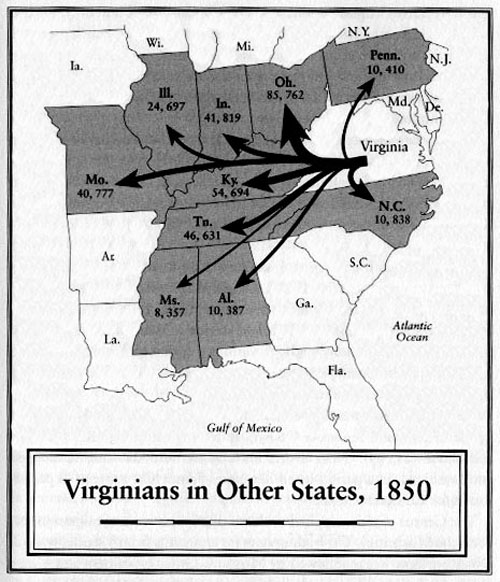
"Bound Away: Virginia and the Westward Movement", David H. Fischer and James C. Kelly [479]
Where Did the Milam Apple Originate?
Given this research, can we make an educated guess about where the Milam apple originated? Most of the authors credit the Milam apple as a southern apple and a few point specifically to Virginia or possibly Kentucky as the origin. We learned from James Fitz of Keswick, Virginia, that the Milam was "a splendid apple in the Piedmont District of Virginia and was much admired there". [465] And we know that by 1818, it was cultivated in fruit nurseries by Zebulon Gillett in southeastern Ohio and by Joseph Curtis in eastern Illinois. This means that, for the Milam to have such a favorable reputation by then, it must have been discovered and propagated several years before that. [472, 473]
Where were southern Milams living in the late seventeen hundreds and early eighteen hundreds? The bulk of them were living in Bedford County and Halifax County in the southern Piedmont of Virginia. And, where were the earliest horticultural societies founded in Virginia - in Bedford County and Charlottesville. The latter fact indicates where the interest in growing and improving apples, peaches, plums and other fruits was the greatest. [451]
My best guess is that the Milam apple was discovered as a seedling by one of Thomas Milam's sons in Bedford County. But it is possible that it was old Thomas himself who found the Milam apple in present day Madison County - as one legend suggested - and brought it with him to Bedford in 1761.
It appears doubtful that it was John Milam of Halifax County or one of his sons since by 1800 most of them had emigrated south to North Carolina, South Carolina and Georgia. Moses, son of Thomas, did remove to Fayette County, Kentucky, about 1789 and Moses might have taken the Milam with him.
Unless we find an orchard mentioned in a Deed or a Will, we will probably never know who discovered the Milam apple. But it seems satisfaction enough to know that a Milam discovered and propagated an apple which spread from coast to coast and still - two hundred years later - is considerd one of the 192 exceptional varieties of North America. [477]
NOTE TO READERS: All the words in bold regular type face are links to photographs, maps or word definitions in the Glossary.
